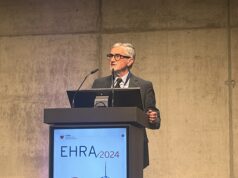 An international consensus statement on how to treat atrial fibrillation (AF) with catheter or surgical ablation has been published today in EP Europace and presented at the European Heart Rhythm Association (EHRA) 2024 congress (7–9 April, Berlin, Germany).
An international consensus statement on how to treat atrial fibrillation (AF) with catheter or surgical ablation has been published today in EP Europace and presented at the European Heart Rhythm Association (EHRA) 2024 congress (7–9 April, Berlin, Germany).
Lead author Stylianos Tzeis (Mitera Hospital, Athens, Greece), said: “Ablation is the most effective way to prevent recurrences of atrial fibrillation and delay progression to more advanced forms. Pioneering techniques have emerged since the previous consensus in 2017,3 requiring new advice on who should receive this procedure and how to perform it in the safest and most effective manner.”
Atrial fibrillation is the most common cardiac arrhythmia, affecting 2% of individuals worldwide. The number of people with the disorder has risen three-fold over the last 50 years and is expected to increase further.
Today’s document sets out best practice standards and practical advice on which patients should receive ablation, how to perform the procedure, and how to manage patients before, during and afterwards. A healthy lifestyle is advised to reduce the risk of developing atrial fibrillation and to lower the number of recurrences.
Catheter ablation is beneficial as first-line treatment in patients with symptoms and recurrent atrial fibrillation. It is also beneficial in symptomatic patients with recurrent paroxysmal or persistent atrial fibrillation who are resistant or intolerant to at least one antiarrhythmic drug.
Patients with atrial fibrillation and heart failure, a condition in which the heart muscle cannot pump enough blood to meet the body’s needs, benefit from ablation to alleviate symptoms, increase the heart’s strength, and improve their prognosis.
Before the procedure, patients should have an electrocardiogram (ECG) and echocardiogram to check the heart’s rhythm and function. Some patients need computed tomography or transoesophageal echocardiography to exclude the presence of a blood clot in the heart. Blood thinners should not be interrupted before catheter ablation and patients should receive specific instructions from their healthcare provider on continuing their medication.
After the procedure, all patients should receive anticoagulation for at least two months. Prolonged anticoagulation may be required depending on the risk of blood clots. Antiarrhythmic drugs are advised for some patients to prevent arrhythmia recurrences early after the procedure. Complications following catheter ablation are uncommon but can include stroke, pericardial tamponade, transient ischaemic attack, and vascular complications at the access site in the groin. The risk of death is extremely low (0.05–0.1%).
Tzeis said: “Technological innovations have made catheter ablation safer and more effective than ever before. For example, we now have pulsed field ablation which uses high energy electrical pulses to treat atrial fibrillation without damaging the nerves or oesophagus. We can also use intracardiac echocardiography to guide and facilitate the procedure with real-time visualisation of the cardiac structures being treated.”












